Coat of arms of the Counts of Veringen
The coats of arms of Veringen , Nellenburg and Württemberg each show three stag poles lying on top of each other in a golden shield and differ only in the colors of the stag sticks. They testify to their family relationships.
Coats of arms of Veringen, Württemberg, Nellenburg and Grüningen-Landau
Coat of arms from the Zurich coat of arms from around 1340
Coat of arms of the Counts of Veringen
Coat of arms of the Counts of Württemberg
Coat of arms of the Counts of Grüningen-Landau
Coat of arms of the Counts of Nellenburg
The coat of arms of the Counts of Grüningen-Landau is identical to the Württemberg coat of arms. This coat of arms came from the Counts of Veringen via the Counts of Württemberg to the Counts of Grüningen-Landau. It was first found as a seal on a document issued by Count Konrad (III.) Von Grüningen in 1228.
References to the Veringian coat of arms
| coat of arms | Explanations |
|---|---|
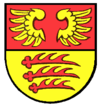
|
Benzingen
Benzingen came into the possession of the Counts of Veringen at the end of the 13th century. The three red deer poles lying on a golden background bear witness to this time. |
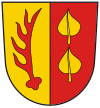
|
Beuren (Isny)
After changing partial affiliations to the monastery and imperial city of Isny and to the Trauchburg rule , after the Peasants' War it came under the influence of the Waldburg-Zeil rule. |
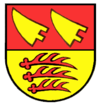
|
Billafingen
Billafingen originally belonged to the County of Veringen until 1291, before it was sold to the Habsburgs and thus became part of Upper Austria. Today Billafingen belongs to the municipality of Langenenslingen. |
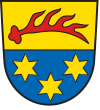
|
Christazhofen
The red stag stick in gold is taken from the coat of arms of the Counts of Veringen, who are the oldest known owners of the Trauchburg estate , to which Christazhofen also belonged. In the lower half of the shield appears the coat of arms of the Lords of Neideck, whose headquarters are in the Christazhofen district. |
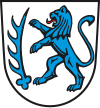
|
Gammertingen
The coat of arms shows the lion of Count von Gammertingen, who founded the city in the 12th century. Gammertingen received town charter in 1265, which at that time was owned by the Count of Veringen. The stag stalk comes from the coat of arms of the Counts of Veringen. This combination can be seen for the first time on a seal of the city from the late 14th century. The colors have been known since 1535. The coat of arms was established in 1952. |

|
Pfronstetten -Geisingen |
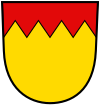
|
Harthausen on the shear
Harthausen auf der Scheer has no historical seals or coats of arms. This is why the State Archives in Sigmaringen designed this coat of arms in 1947. The main element symbolizes sharp-edged rock spikes (Scheer). The colors correspond to the coat of arms of the Counts of Veringen, the oldest known owners in the 13th and 14th centuries. The coat of arms was officially established on January 28, 1949. In 1975 Harthausen was incorporated into the municipality of Winterlingen. |
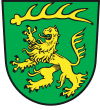
|
Hettingen
Hettingen was first mentioned as a city in 1407 and the oldest seal comes from the same time. The seal already shows this coat of arms. It shows the lion of the Counts of Gammertingen, who founded the city in the 12th century. Hettingen later became the property of the Counts of Veringen, from whose coat of arms the stag stem comes. The first colored illustration is known from 1535, but the colors have changed several times since then. The current colors have been in use since the mid-19th century and were officially adopted in 1952. When the municipalities were amalgamated with Inneringen on October 6, 1977, a new coat of arms was established. The new coat of arms connects the lion from the old coat of arms with the rings from the old coat of arms of Inneringen. |
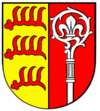
|
Huldstetten |

|
Langenenslingen
In a divided shield above in red on a green three-hill three golden deer feet, below in gold three red deer poles one above the other. The coat of arms in the upper half of the shield corresponds to the seal of Heinrich von Enslingen from 1341. The three red deer sticks in gold, as the coat of arms of the Counts of Veringen, refer to the fact that the place belonged to the County of Veringen in the 14th century. |

|
Neutrauchburg
Neutrauchburg was owned by the Counts of Veringen in a very early period. In 1096 Irmingard von Veringen gave her son Manegold the place Mechinsowe (later Neutrauchburg). |
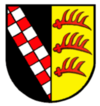
|
Riedetsweiler
Riedetsweiler is part of the community of Wald and is located about five kilometers west of Pfullendorf. The three red stag sticks in a golden field indicate the Counts of Veringen, who owned Riedetsweiler in the 13th century. |
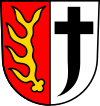
|
The stag bar in the Trochtelfingen coat of arms refer to Veringen and Württemberg. |

|
Veringendorf
The municipal coat of arms of Veringendorf corresponded exactly to the coat of arms of the Counts of Veringen. It goes back to a proposal made by the Sigmaringen State Archives in 1947. The award took place on February 15, 1949 by the Ministry of the Interior of Württemberg-Hohenzollern. It lasted until the district reform in 1977. |

|
Veringenstadt
The current coat of arms was officially approved in 1947. Veringen received city rights in 1285. As early as 1320, the lion and the stag pole were used as city arms. The lion comes from the Habsburg coat of arms. The stag pole is derived from the coat of arms of the Counts of Veringen. |

|
Wilsingen -Trochtelfingen |

|
Wenigzell Styria
The coat of arms was approved on June 29, 1982. The pearl ribbon is a reference to Saint Margret, patron saint of the Wenigzell Church. The claw wing is taken from the coat of arms of the Vorau monastery. The stag bar comes from the coat of arms of Count Wolfrad von Treffen (12th century). He belonged to the Veringen - Isny family (12th century), which brought the first settlers to Wenigzell. |
See also
Web links
Footnotes
- ^ A b Thomas Fink: Collection of materials on the history of the city of Veringen. Volume 13: Coats of arms of the Counts of Veringen and related coats of arms.
- ^ Coat of arms of Württemberg
- ^ Sönke Lorenz, Dieter Mertens, Volker Press. The House of Württemberg: A Biographical Lexicon. Stuttgart: Kohlhammer 1997. ISBN 3-17-013605-4
- ↑ The history of the Nellenburg. Retrieved October 1, 2015 .






